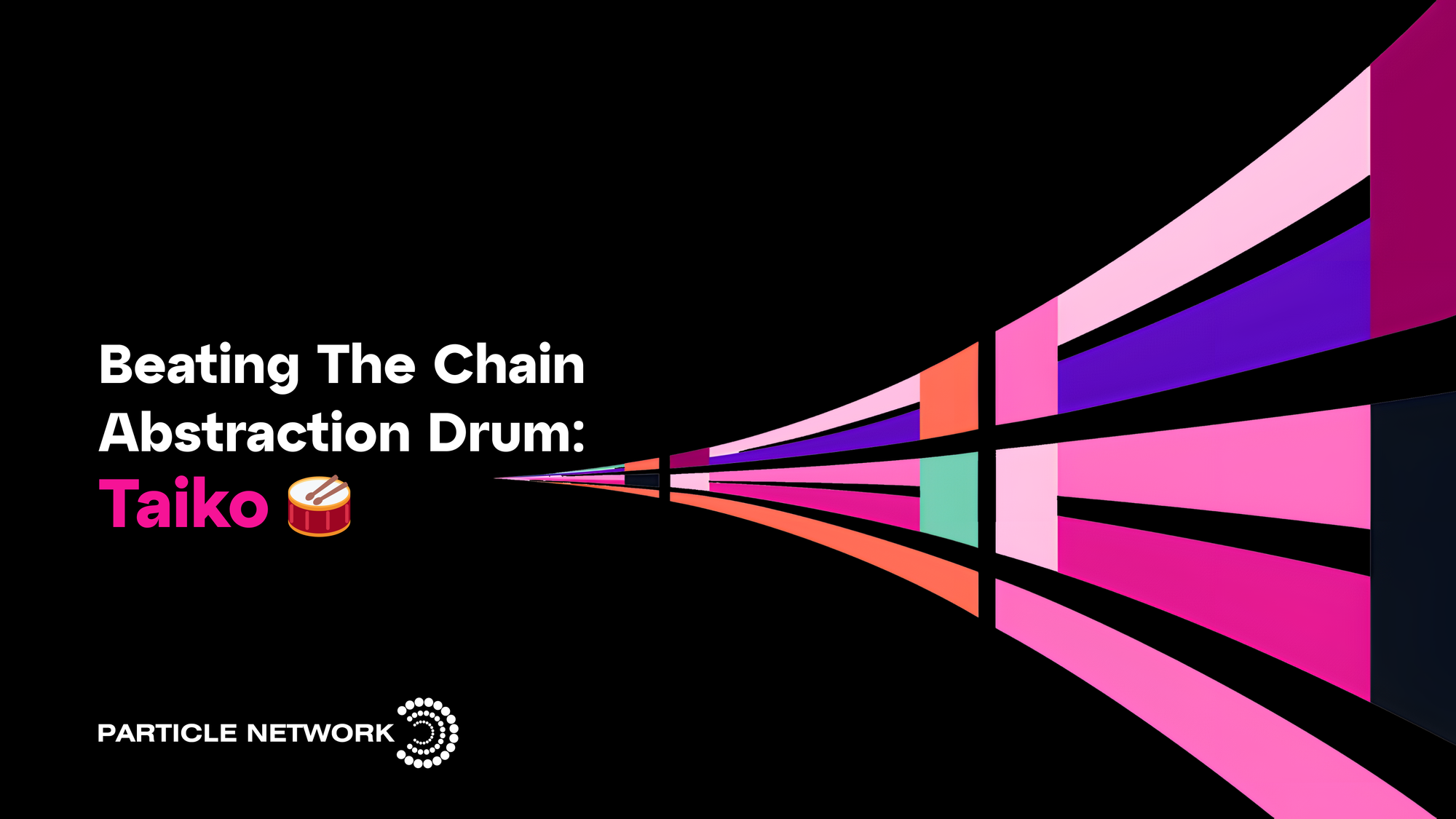Beating the ChA Drum: Q&A with Taiko on Chain Abstraction, its Ecosystem, and Embracing a Borderless Web3

Table of Contents:
It’s safe to say that Web3’s ecosystem of L2s and modular blockchains has finally solved scalability.
Nowadays, cost-effective, expansive blockspace is accessible to any developer and end-user, defeating some of Web3’s major infrastructural issues. This marks the end of an era for Web3, leading to a new challenge: Unification.
These days, infrastructure conversations revolve around allowing users to navigate the entirety of the decentralized Internet without manually juggling multiple chains. In essence, we're witnessing the genesis of a cohesive Web3 experience that transcends individual blockchain boundaries.
For this article, we had the privilege of discussing the main driver of this new Age, aptly named chain abstraction (ChA), with Taiko: One of the first members of the Chain Abstraction Coalition, and key participants of our second Co-Testnet. In this conversation, Taiko shared its team’s perspective on ChA's potential, the Coalition’s goals from the standpoint of a successful L2 chain, and the evolution of Web3.
First of all, what is Taiko?
Taiko is a fully permissionless, Ethereum-equivalent based rollup. It makes Ethereum cheaper while maintaining its core properties. Through its unique architecture, Taiko leverages Ethereum for transaction sequencing using a method called Based Sequencing.
Taiko has bootstrapped a unique community built around the L2’s no-nonsense approach to security, as well as a fully open-source philosophy. This has led to the emergence of a rich ecosystem of dApps.
Q&A: Taiko on its unique ecosystem, its involvement in the Coalition, chain abstraction, and the new era of Web3
#1: What projects would you highlight within your ecosystem that make Taiko unique or that you think make the most out of your capabilities?
The Taiko ecosystem, although nascent, is growing rapidly. We are working closely with several projects and continuously adding new ones with solid teams. Our approach differs from other ecosystems as we focus on sustainability and ensuring that the liquidity in the ecosystem is sticky.
#2: How do you feel about chain abstraction, both in terms of the technologies enabling it and as a trend?
Chain abstraction is pivotal as it simplifies interactions with multiple blockchains, making cross-chain operations seamless for developers and users. Technologies like cross-chain messaging protocols and modular blockchain designs enable this abstraction, reducing friction and promoting a more interconnected Web3 ecosystem. For Taiko, this trend aligns with its goal of maintaining Ethereum equivalence while fostering interoperability, allowing it to integrate effortlessly into a broader multi-chain environment.
#3: What are your "predictions" for Web3 as it increasingly becomes borderless and simpler to use? What would be your more controversial/unpopular takes?
As Web3 becomes more user-friendly and borderless, we foresee a significant shift towards decentralized identity and data ownership, where users control their digital assets across platforms without centralized intermediaries. A more controversial take is that we may see a pushback against overly abstracted chains, with some users and developers preferring networks that offer distinct identities and specialized features. Taiko, with its focus on Ethereum equivalence and zk-rollup scalability, is well-positioned to cater to both ends of this spectrum.
#4: What characteristics of Taiko do you think can help it attract developers once chain abstraction is broadly introduced across Web3?
Taiko's Ethereum-equivalent architecture will be a key attraction for developers in a chain-abstracted world. It allows them to build and deploy with familiar tools while benefiting from the scalability and security of zk-rollups. The seamless transition from Ethereum to Taiko, without needing to learn new languages or paradigms, will be a significant draw for developers seeking to leverage Ethereum's ecosystem with improved performance.
#5: Chain abstraction will undoubtedly lead to a whole new paradigm for blockchains to compete and collaborate. In what ways do you think this can benefit you as a relatively new ecosystem, and how do you see your user and developer base adapting to this?
Chain abstraction opens up new avenues for Taiko to collaborate with other blockchains while competing on its unique strengths, such as zk-rollup scalability and Ethereum compatibility. This will benefit Taiko by increasing its appeal to developers who seek to build cross-chain dApps. As chain abstraction simplifies the development process, Taiko's focus on maintaining Ethereum equivalence while offering enhanced scalability will attract a diverse user base, eager to leverage these benefits in a multi-chain environment.
#6: How does Taiko's participation in the Chain Abstraction Coalition align with your long-term strategy for ecosystem growth and developer adoption?
Taiko's involvement in the Chain Abstraction Coalition aligns with its long-term strategy by promoting interoperability and cross-chain collaboration, key to attracting developers and projects looking for flexible, scalable solutions. This participation reinforces Taiko's commitment to being a vital part of the broader Web3 ecosystem, ensuring its zk-rollup technology is integrated into emerging multi-chain standards and practices.
#7: As the ecosystem begins to care more about "specialized" blockchains, what items in your roadmap do you believe will help your chain stand out the most in the future?
As specialized blockchains gain traction, Taiko's roadmap, which emphasizes zk-rollup scalability and Ethereum equivalence, will be crucial. These features ensure that Taiko can handle complex, high-throughput applications while maintaining the developer-friendly environment of Ethereum. This combination will help Taiko stand out as a high-performance, versatile platform in the Web3 landscape.
#8: What specific kind of projects do you think Taiko has an edge to attract within a borderless Web3 paradigm?
Taiko is particularly well-suited to attract DeFi, gaming, and NFT projects that require high scalability and low transaction costs while maintaining Ethereum compatibility. The zk-rollup technology enables these projects to achieve performance that rivals or exceeds Layer-1 solutions, making Taiko an attractive choice for developers looking to build scalable applications without compromising on security or decentralization.
#9: In a chain-abstracted world, what relationship do you think end-users will have with your chain? Will they think of it as mere infrastructure they're not aware of at all times, or will they retain a unique relationship to It?
In a chain-abstracted world, end-users will likely view Taiko as a highly performant, yet largely invisible layer of infrastructure that underpins their decentralized applications. However, due to Taiko's Ethereum-equivalent ZK-Rollup design, which ensures EVM compatibility and leverages Ethereum's security guarantees, technically savvy users and developers might retain a unique relationship with Taiko. This is because they will recognize the advanced scalability, security, and privacy features it provides, particularly in environments where these attributes are critical. Thus, while the general user might see Taiko as seamless infrastructure, developers and power users will appreciate and specifically choose Taiko for its robust technical architecture and its alignment with Ethereum's decentralized ethos.
—Many thanks to Swarnabha Sinha, Taiko’s Solutions Engineer, for these answers!
Chain abstraction is inevitable
As Web3 moves towards greater interconnectedness, chain abstraction (ChA) is becoming a cornerstone of its evolution. By joining the Chain Abstraction Coalition and the conversation around Web3’s unification, blockchains like Taiko are setting themselves up to become leaders in this transformative era.
We’re genuinely excited to see more blockchain ecosystems voicing their stance on ChA. This only showcases our ecosystem’s main players’ are ready to collaborate and compete in a truly borderless future, accelerating Web3’s adoption and fostering the creation of better dApps along the way.
We’ll say it again: Chain abstraction is inevitable.
Particle Network's Chain Abstraction solutions are 100% free for developers and teams. By integrating them, you can set your project in a path to leveraging chain abstraction.
About Particle Network

Particle Network powers chain abstraction, addressing Web3's fragmentation of users and liquidity. This is enabled by Particle's Universal Accounts, which give users a unified account and balance across all chains.
Share this article
About the author(s)


